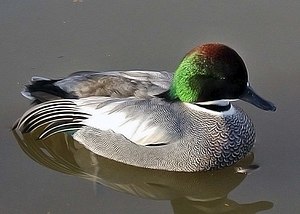Sickle duck
| Sickle duck | ||||||||||||
|---|---|---|---|---|---|---|---|---|---|---|---|---|

Sickle duck, male |
||||||||||||
| Systematics | ||||||||||||
|
||||||||||||
| Scientific name | ||||||||||||
| Mareca falcata | ||||||||||||
| Georgi , 1775 |
The sickle duck ( Mareca falcata , syn .: Anas falcata ) is a species of swimming duck that breeds in eastern Siberia and Japan . In its splendid plumage, the male has strongly elongated shoulder feathers that fall far over the back of the back.
It has been observed increasingly in Central Europe in the last few decades, although most of them are likely to be prisoner refugees. For the Netherlands, however, there are only five observations of animals that are recognized as wild birds in the 1990s.
Appearance
The sickle duck is a relatively small duck. The body length is between 48 and 54 centimeters. Males weigh between 590 and 770 grams. Females are a bit lighter and weigh between 442 and 700 grams.
In their splendid plumage, males have very contrasting plumage. The forehead and crown are reddish brown. A blurred black stripe runs over the eyes. The plumage is metallic green from the eyes to the neck. The head looks very big because of the forelock. The front and rear breasts are dark gray and lightly scaled. This scaling is significantly smaller on the flanks. The strongly elongated shoulder feathers, which are sickle-like over the rear part of the back, are striking. They gave rise to the name Sichelente in German usage. When resting, the male resembles the female. However, the head has a greenish tinge and the cheeks are darker than the female.
The female resembles most of the females of the duck proper. Their plumage has shades of tan and brown. The crescent-shaped markings on the chest are striking. In the female, too, there is a tuft on the back of the head, which makes the head appear significantly enlarged.
Both sexes have gray-tinged forewings. In flight, however, the white fringes of the green mirror of the arm swing stand out more clearly. The beak is dark gray to black in both sexes. The legs are yellowish to bluish gray and have darker webbed feet.
voice
Sickle ducks are very quiet birds outside of their immediate breeding area. The male calls out tyu-tyu-vit ... tyu-vit ... tyu-tyu-vit , and softly uit-trrr . The female has a rough croak. Until 2005, no sonograms were published for the calls of the sickle duck .
Distribution and existence
The sickle duck is a breeding bird in eastern Siberia, Mongolia, northeastern China, and Japan. Sickle ducks only occur occasionally on the Kamchatka Peninsula. Sickle ducks overwinter in central China, southern Japan and Korea, and occasionally penetrate to southern Vietnam, Burma, Thailand and Laos. The extreme north of India is also part of the wintering area. However, mostly females are observed here.
There have been reports of random visitors from Great Britain and France. However, the demarcation from prisoner refugees is not always given. Population estimates range from 100,000 to 1 million individuals. It is certain that fewer than 3000 individuals winter in Korea and almost 8000 in Japan. Although it is quite common in some regions, it is believed that the population will decline. In Japan there is at least a decrease in the overwintering population. She is under hunting pressure. In China in particular, it is hunted for its meat and feathers.
habitat
The sickle duck is a species of duck that is bound to freshwater. It breeds on lakes, ponds, rivers and in swamp areas. She prefers wooded regions. Outside of the breeding season, it can also be found in lagoons, shallow saltwater bays, flood plains and in rice-growing areas. She is basically a shy species that avoids contact with people.
Way of life and reproduction
During the breeding season, they live in pairs or in small family groups. Outside of the breeding season, they can also be seen in larger schools. The egg-laying time in Russia falls between May and early June. Sickle ducks that breed in India usually only lay eggs in June.
Sickle ducks usually nest on the ground near water. The clutch usually consists of eight to nine eggs. These are yellowish pink in color. The female breeds alone. The male stays close to the female at the beginning of the breeding season. Then the male moves to the moulting areas. The downy chicks hatch after a breeding period of 24 to 25 days. Dunen chicks hatched in captivity had an average weight of 27.2 grams. So far, there is insufficient data on the breeding behavior in the wild. Sickle ducks probably only raise one brood per year.
supporting documents
Web links
- Mareca falcata inthe IUCN 2013 Red List of Threatened Species . Listed by: BirdLife International, 2012. Retrieved September 30, 2013.
Individual evidence
- ↑ Hans-Günther Bauer, Einhard Bezzel and Wolfgang Fiedler (eds.): The compendium of birds in Central Europe: Everything about biology, endangerment and protection. Volume 1: Nonpasseriformes - non-sparrow birds , Aula-Verlag Wiebelsheim, Wiesbaden 2005, ISBN 3-89104-647-2 , p. 87
- ↑ Gooders and Boyer, p. 36
- ↑ Kear, p. 495
- ↑ Kear, p. 495
- ↑ Gooders and Boyer, p. 37
- ↑ Kear, p. 496
- ↑ Kear, p. 496
- ↑ Kear, p. 496
- ↑ Kear, p. 496
literature
- Janet Kear (Ed.): Ducks, Geese and Swans. Oxford University Press, 2005, ISBN 0198546459 .
- Hartmut Kolbe; Die Entenvögel der Welt , Ulmer Verlag 1999, ISBN 3-8001-7442-1
- John Gooders and Trevor Boyer: Ducks of Britain and the Northern Hemisphere , Dragon's World Ltd, Surrey 1986, ISBN 1-85028-022-3

